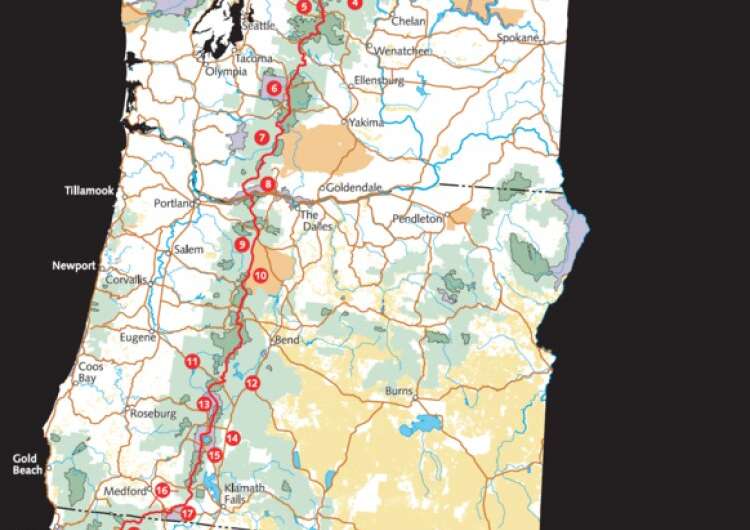
To the uninitiated, the increasingly popular—but still niche—outdoor pursuit known as thru-hiking can sound exhausting, boring and dangerous.
Not many people relish the notion of sleeping on the ground, no Netflix, infrequent showers, eating a high-calorie, low-quality diet—Snickers bars, ramen noodles, Pop-Tarts, that sort of thing—and carrying a loaded backpack while trekking thousands of miles on the often-grueling terrain of a “long trail”—most famously, America’s 2,193-mile Appalachian, 2,653-mile Pacific Crest and roughly 3,000-mile Continental Divide National Scenic Trails—for four to six months.
Yet for those who take to it, thru-hiking can be life-changing. Deep friendships form, and soulmates sometimes meet, in the crucible of trail life. Some hikers experience spiritual awakening or walk off their demons. And many reach the end of a trail more tanned, lean and fit than they’ve been since childhood.
But while thru-hikers may look the picture of health on the outside, two researchers at the University of Colorado Boulder’s Department of Integrative Physiology have published a study suggesting that a thru-hiking lifestyle may lead to troubling changes in vascular health.
“In addition to the extreme exercise load, the subject performed to complete the PCT (Pacific Crest Trail), the individual consumed a very poor diet for the duration of the hike. The results of this case study suggest that the combination of extreme exercise and poor diet may lead to negative changes in health markers,” write Thomas C. Heinbockel, a professional research assistant and Assistant Research Professor Daniel H. Craighead in “Case studies in physiology: Impact of a long-distance hike on the Pacific Crest Trail on arterial function and body composition in a highly fit young male,” published in Physiological Reports in October.
The study was based on Heinbockel’s 2019 thru-hike from the U.S.-Mexico border at Campo, California, to Manning Park, British Columbia, which he started two days after finishing his master’s degree at CU Boulder.
“We knew I was going to do the hike, and we had the machinery in the lab to measure various things,” says Heinbockel (MIntPhys’19), who also happens to be the aforementioned “fit young male.”
“So, we just kind of went for it.”
The two men first met at Penn State, where Craighead was doing a Ph.D. and Heinbockel—whose “trail name” is Tarzan—was a research intern. Both were runners interested in exercise science, and when Craighead came to CU Boulder, he encouraged Heinbockel to pursue graduate studies in Boulder.
Heinbockel started hiking in early May, just days after graduating with a master’s degree, traversing some 700 miles of southern California desert before entering the Sierra Nevada mountains after one of the snowiest winters on record. He continued through northern California, Oregon and Washington, reaching the northern terminus after just 112 days, an average of 23.7 miles per day; typical Pacific Crest Trail hikers take 135 to 150 days to finish.
Many thru-hikers form “trail families” that hike together for hundreds or thousands of miles, but Heinbockel seldom saw people more than once as he blazed past.
“It was sort of my goal to be alone. I hiked fast during the days and tried to hike as many miles as I could each day, to see what my body was capable of,” he says. He also needed to complete the hike before his leave at the lab ended.
But even moving at such a swift pace, Heinbockel says the Pacific Crest Trail surpassed the Appalachian Trail—known for its highly social culture—in almost every way.
“The PCT has far better scenery, weather, trail maintenance, culture and wildlife,” he says.
Then, just four days after finishing his hike, Heinbockel was back in the lab, where Craighead took vascular measurements to match data collected before the hike. The results of their subsequent analysis revealed troubling changes to arterial function.
Brachial artery flow-mediated dilation, a measure of vascular endothelial function, decreased by more than 25%, they found, and aortic stiffness increased by about 5%. Such changes to the endothelial lining of blood vessels are more typically seen in older or less-healthy patients with increased risks for heart attack and stroke.
Despite launching the project purely out of personal interest, “When we saw the results, it was clear we should try to publish,” Craighead says.
“Here was someone healthier than 99.9% of Americans, at very low-risk for cardio-vascular disease, very physically active every day, showing these changes. … We took someone who was super healthy and brought them down a fair amount in 112 days.”
Since regular exercise is a boon to cardiovascular health, Craighead and Heinbockel speculate that the combination of a poor diet and extreme daily exertion caused the changes.
Heinbockel fueled his hike with a typical thru-hiker diet of ramen noodles, instant mashed potatoes, peanut butter, tortillas, energy bars, jerky and nuts on the trail—inexpensive foods dense in calories, salt and sugar—and indulged in ice cream, burgers and pizza when in town to resupply, to sate the legendary “hiker hunger.”
The researchers regret that they did not take further measurements a month or more after the hike, to see if Heinbockel’s vascular condition bounced back.
“We don’t know how persistent these effects are,” Craighead says.
Still, the implications for thru-hikers are clear: “It is important for individuals completing a long-distance hike to be aware of the potential deleterious changes associated with large volumes of exercise and consuming a high-calorie, low-quality diet,” they conclude in the paper.
And while it’s unlikely that thru-hikers, ever conscious of budget, convenience and the weight of their packs, will make wholesale changes to trail diets, the researchers say they should actively seek to undo their “prolonged period of a high-fat, high-sugar diet” once off the trail.
“I recommend they eat a diet high in fiber, fruits and vegetables,” Craighead says.
The study lays groundwork for future research on larger groups of hikers, but the unusual nature of thru-hiking can make for a challenging subject, the researchers say.
Source: Read Full Article